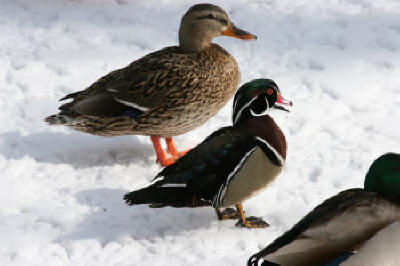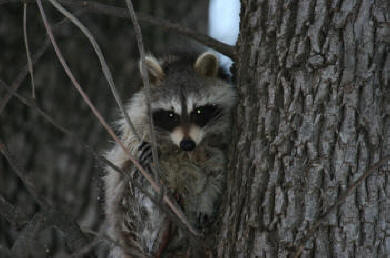
Habitat Facts
Range
Once one of the most
abundant species of waterfowl in North America, the Wood Duck’s population now
consists primarily of two fairly distinct groups. The largest population is
located east of the Mississippi River, spreading towards the Atlantic Ocean.

The smaller population is located further west, in the mountain states of Washington and Oregon, and spreading north into British Columbia. During the breeding season the birds are found throughout southern Canada. Weather-permitting, some birds are found throughout America year-round. The largest area on the map, shaded purple shows how many birds choose to spend a majority of their time in the same general area.
Nesting
As its name implies, the Wood Duck’s habitat often includes heavily-wooded wetlands. One of only a handful of perching ducks, the Wood Duck is known to make its nests in cavities formed in trees by woodpeckers, natural decay, or a combination of the two.
During the last 100 years or so, in an effort to rehabilitate the Wood Duck’s population, man-made nest boxes have gained popularity, and have successfully helped boost the bird’s numbers. Unfortunately however, the boxes also serve as suitable habitats for species like minks, squirrels, and other birds.
Sharing the Territory
Because the Wood Duck as a species occupies such a large
range, it encounters many specific types of organisms, ranging from other ducks
and geese to mammals like the
white-tailed deer.
 The Wood Duck typically shares its home with other puddle ducks like mallards,
and has been known to (in rare instances) interact with the Mandarin Duck, its
closest relative.
The Wood Duck typically shares its home with other puddle ducks like mallards,
and has been known to (in rare instances) interact with the Mandarin Duck, its
closest relative.
Predators
Some predators of the Wood Duck include reptiles such
as
snapping turtles,
mammals such as squirrels and raccoons, and even other birds such as
bald
eagles and
peregrine falcons. Much of this predation occurs before the
ducks reach maturity, but there have been documented cases of eagles taking
fully-grown ducks literally out of the sky.
literally out of the sky.
By far the most significant natural predator of the wood duck is the raccoon. This "masked menace" has been known to devastate entire Wood Duck nests, the hen included.
For this reason, hens are especially wary about choosing their nesting sites, and when to emerge to feed for fear of being seen or leaving her eggs unattended.
Mankind and the Wood Duck
The most significant predator to mature Wood Ducks is man. Over-hunting the late
19th-early
20th
Centuries nearly drove the Wood Duck to extinction. Because of the uproar that
resulted, stricter hunting regulations were adopted across all species, and a
greater emphasis on conservation resulted.
The picture on the right is a good example the scarred history man shares with the Wood Duck. The photo depicts a woman surrounded by the bodies of countless ducks. Market hunting like this was common in areas with lots of wildlife, and the consequences were nearly disastrous.
Besides the obvious effects of over-hunting, man is still threatening the Wood Duck's way of life today. By removing decaying trees, and developing wetlands man is destroying the preferred nesting areas of the bird. Fewer nesting sites translates into fewer birds being able to breed. This cause and effect relationship has driven the Wood Duck out of several areas, resulting in some disparities in the above range map.
Next, learn about the lifestyle of the Wood Duck.
Questions or comments? Email me at larson.chri@students.uwlax.edu